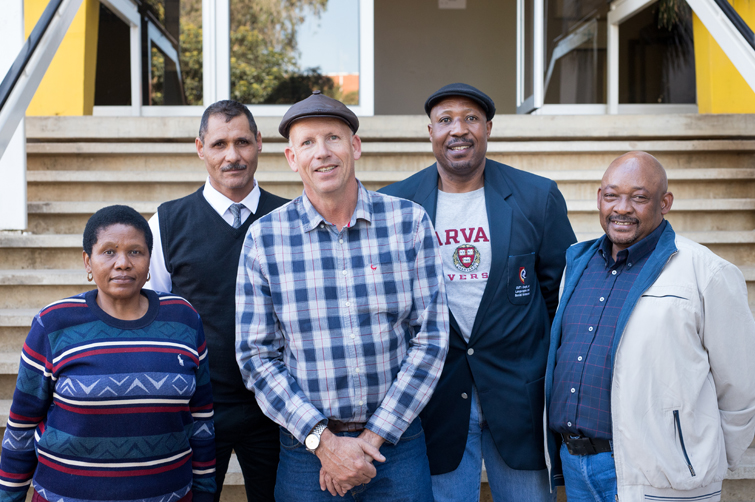Latest News Archive
Please select Category, Year, and then Month to display items
13 January 2020
|
Story Eugene Seegers
|
Photo Anja Aucamp
 Spearheading the digital expansion of the conversational Sesotho course is IDEAS Lab Director, Johann Möller (middle). With him are from the left: Prof Pule Phindane, CUT; Dr Brenton Fredericks, CUT; Bahedile Letlala, UFS Department of African Languages; and Dr Elias Malete, UFS Department of African Languages.
Spearheading the digital expansion of the conversational Sesotho course is IDEAS Lab Director, Johann Möller (middle). With him are from the left: Prof Pule Phindane, CUT; Dr Brenton Fredericks, CUT; Bahedile Letlala, UFS Department of African Languages; and Dr Elias Malete, UFS Department of African Languages.
For many years now, the UFS has been offering a one-year course in conversational Sesotho for staff members; this can then be followed up with the one-year course in advanced conversational Sesotho. The conversational Sesotho for students in the Faculty of Education was introduced in 2018 at the UFS.
The Central University of Technology (CUT) needed a conversational course for its first-year students and approached the Department of African Languages for the development of such a course. Living as we do in a multilingual country; this additional language skill opens doors and often hearts as well.
Using instructional design principles
However, the need was identified by both CUT and UFS to present this crucial information in a way that would be more appealing to digital natives as well as to those less familiar with technology. The Department of African Languages on the UFS Bloemfontein Campus, together with relevant departments from the CUT, approached the IDEAS Lab located on the UFS South Campus, since they already have a reputation for being a specialist on broadcasting and repackaging curricular content for digital presentations. The IDEAS Lab provided technical advice and built the multimedia programme, which will help the user to hear and practice phrases in Sesotho, using instructional design principles. The course will be available to both staff and students belonging to the two universities.
Room for growth
Johann Möller, Director of the IDEAS Lab, says this pilot programme will give both institutions the opportunity to test the use of multimedia for language acquisition. He adds, “Language is extremely complex, and we would like to expand this learning aid in the future.” In fact, the original design has room for growth built into it.
To keep things simple for the user and the building team, it was decided to start out with only four potential everyday scenarios where a staff member would like to speak Sesotho: Firstly, how to greet other persons from different genders; secondly, potential scenarios one might encounter in the university environment itself; thirdly, how to deal with situations at a hospital; and finally, how to use one’s language skills at a filling station.
Pronunciation is key
Each scenario contains three to four conversations that the learner can revise, along with images and audio that illustrate the situation and assist with correct pronunciation. The system does not allow the user to progress unless they have listened to the pronunciations of the sample sentences or phrases.
Further reading material and vocabulary lists are also provided, with the result that people who are using the programme can learn at their own pace. The authoring software Articulate Storyline was used to build the individual scenarios and each conversation or lesson within it. The lessons are also not dependent on an internet connection; they can be downloaded onto a flash memory drive and used offline.
Childhood obesity should be curbed early
2017-03-15

Serious intervention by parents is required to deal
with childhood obesity. Prof Louise van den Berg and
a group of final-year PhD students worked on a study
about the prevalence of obesity in six-year-olds in
South Africa.
Photo: Supplied
If your child is overweight when they start school at the age of six, unless you do something about it at that point, the indications are they are going to be overweight teenagers and obese adults. This is according to University of the Free State’s Prof Louise van den Berg.
Evidence has shown that overweight children and teenagers have a greater risk of developing lifestyle diseases such as type 2 diabetes, hypertension and cardiovascular disease later in life, and dying prematurely.
Obesity is a global pandemic rapidly spreading among adults and children, in developed and developing countries alike.
Dr Van den Berg worked with Keagan Di Ascenzo, Maryke Ferreira, Monja-Marie Kok, Anneke Lauwrens, all PhD students with the Department of Nutrition and Dietetics, to conduct the study. Their research found that children who are overweight by the time they turn six should be screened for weight problems.
Why six-year-olds?
Children who are overweight between the ages of two and five are five times more likely to be overweight when they are 12. There are two periods in a normal life cycle when the body makes new fat cells. The first is in the uterus and the second is around the age of six. The second phase lasts from the age of six to puberty.
The study assessed the prevalence of obesity in six-year-olds as part of a campaign in South Africa to raise awareness of the problem among parents and educators.
A total of 99 children were chosen from seven schools in Mangaung, the capital city of Free State. The schools were chosen from quintile four and five schools, which when measured by their own resources and economic circumstances, are well resourced and serve largely middle-class and wealthy communities.
The children’s weight, height and waist circumference were measured and used to calculate a body mass index score and waist-to-height ratio. Both these figures are good predictors for future lifestyle disease risks such as type 2 diabetes, hypertension and cardiovascular disease. A person with a good waist-to-height ratio can wrap a piece of string equal to their height around their waist at least twice.
When the children had a higher body mass index, they also had an increased waist to height ratio. The study found one in four children from the schools surveyed were overweight when they started primary school.
Nipping the fat in the bud
Although there are many factors that play a role in preventing childhood obesity, parents’ perceptions of their children’s weight play an important role. A recent study found that more than 50% of parents underestimate the weight of their obese children. These parents remain unaware of the risks their children face and are not motivated to take any action.
At least half of the parents whose children are overweight struggle to recognise their children’s weight problems fearing that they will be labelled or stigmatised. By the time they turn six overweight children should be referred to dieticians and nutritionists who are qualified to guide their parents in getting them to eat well and be more physically active at pre-primary and primary school.
The high prevalence of weight problems among six-year-olds found in this study is an urgent call to healthcare professionals to step up and empower parents, educators and children with the necessary skills for healthy dietary practices and adequate physical activity.